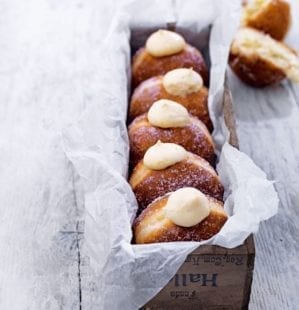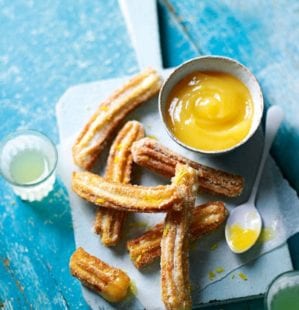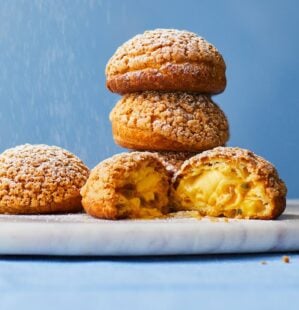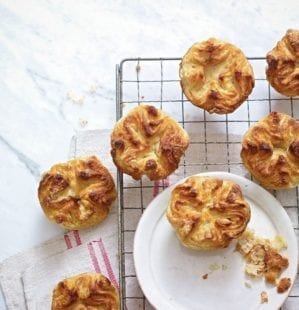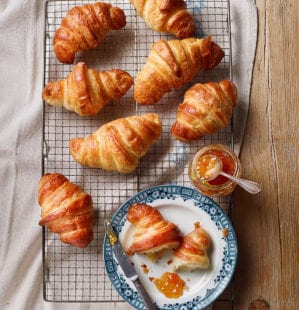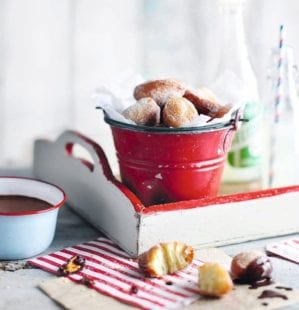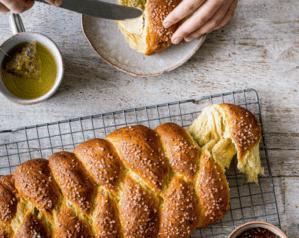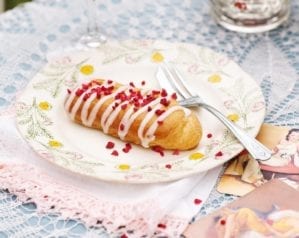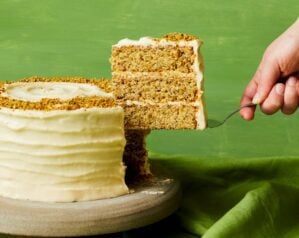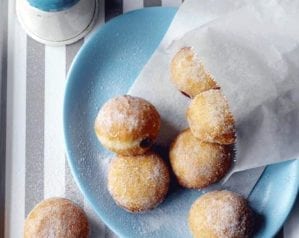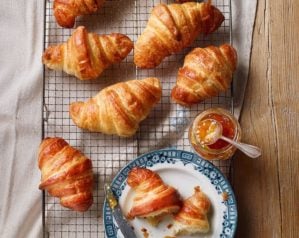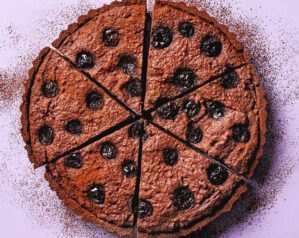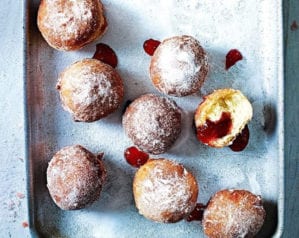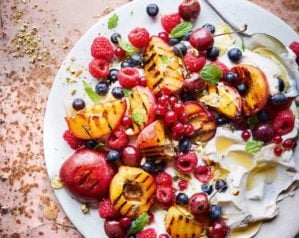
Nicola Lamb’s crullers
- Published: 2 May 24
- Updated: 20 Sep 24
You may not have heard of crullers but, trust us, you’re going to love them. More substantial than a choux bun, lighter (and much quicker) than a doughnut, these elegant pastries have grooves that are ideal for holding a flavourful glaze or topping.
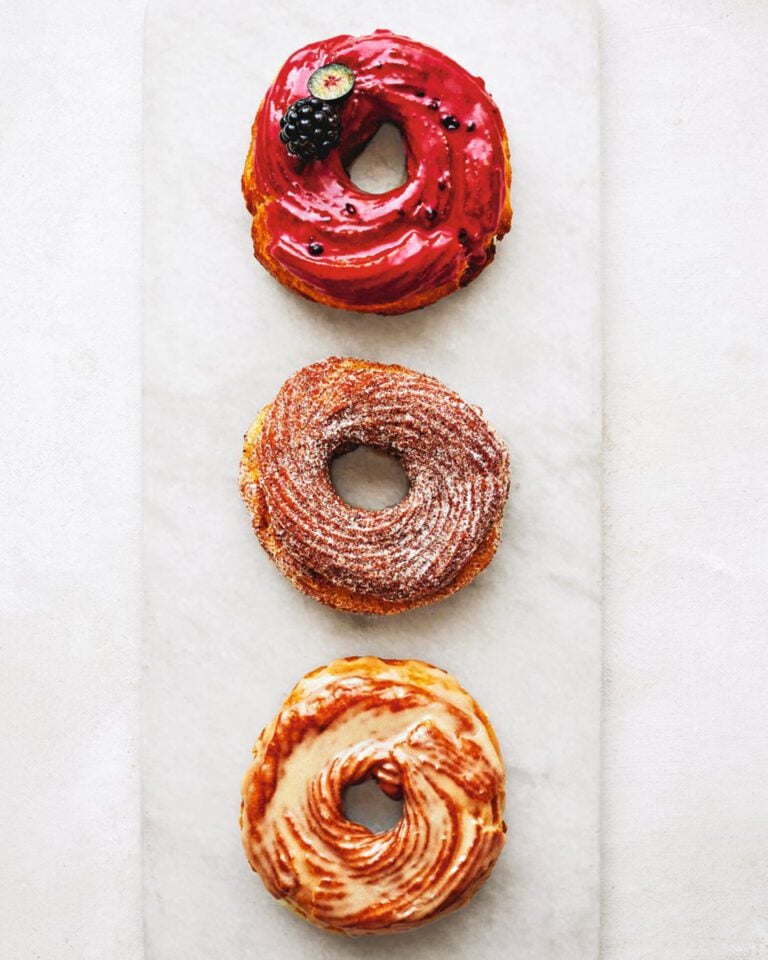
Expert pastry chef Nicola Lamb explains the tricks and techniques needed to achieve cruller perfection – see Tips below for more. Recipe taken from her book Sift (Ebury Press £30) and tested by delicious.
“Airy and slightly gooey inside, crullers are the cool sisters of the doughnut family,” says Nicola. “Try tossing in different flavoured sugars or switching the glaze. You can also use different nozzles to mix up the final look of the cruller – the wider the tip, the more dramatic the result. How about piping different shapes and squiggles – alphabet crullers, anyone?”
Before you start
You’ll need some specialist kit for this recipe: a probe thermometer, a piping bag with a 1.5-2cm fluted nozzle, and some heatproof tongs.
Ingredients
- 40g whole milk
- 55g unsalted butter
- 4g caster sugar
- 75g strong white bread flour
- 110-130g free-range egg (about 2-3 medium eggs)
- Scant ½ tsp salt
- Vegetable oil to deep-fry
Specialist kit
- Probe thermometer
- Piping bag with 1.5-2cm fluted nozzle
- Heatproof tongs
Method
- Pour the milk into a saucepan and add the butter, sugar and 65g water, then bring to a rolling boil. Stir to make sure the sugar is dissolved. Sift the flour several times to prevent lumps, then add into your boiling liquid.
- Turn the heat down and stir rapidly until the mixture turns into a smooth paste and a dry film forms on top. Check it has reached 85°C on the thermometer. Put the paste in a bowl and either spread it out to cool down or beat at a slow speed in a stand mixer with a paddle attachment.
- Meanwhile, whisk the eggs and salt together – this makes them easier to combine as the salt will break down the eggs slightly. When you can touch the paste comfortably for 10 seconds, start to mix in the eggs. I do this in 3-4 additions, mixing well between each one. The choux paste should be smooth and shiny when it’s ready (see Tips). Transfer to a piping bag with a fluted tip or nozzle.
- Pour the vegetable oil into a large deep saucepan – the oil should be at least 5cm deep and there should be at least 5cm between the oil and the rim of the pan. Set it over a medium-high heat and bring to 180°C.
- Meanwhile, cut out 8 x 10cm squares of baking paper. Pipe a 7-8cm ring (about 40g each) of choux paste onto each square (see Tips).
- When the oil is hot, slide the piped choux rings gently into the oil with the paper on, cruller-side down – a maximum of three or so at a time, or as many as you feel confident to do. There’s no rush. Use heatproof tongs to remove the paper as it naturally releases from the crullers. Monitor the oil temperature to ensure it stays at 180°C for the best results. Cook for 3-4 minutes, then flip and cook for another 3-4 minutes.
- Remove the crullers from the oil using a slotted spoon and leave to drain on a cooling rack. While still warm, dip in your chosen glaze or toss in sugar, then leave to set on the rack. Enjoy immediately, or store for up to a day in an airtight container.
For the black ‘n’ blue glaze
Smoosh 30g blackberries, 30g blueberries and 1⁄4 tsp salt together in a bowl, then stir in 200g icing sugar. Add 10-20g lemon juice until the consistency is thick but pourable. Once set on the cruller, decorate with extra blueberries and blackberries.
For the hibiscus glaze
Whizz together 15g dried hibiscus flowers and 1 tsp chilli flakes, then stir into 150g caster sugar.
For the vanilla cinnamon glaze
Whisk together 200g icing sugar, 50g whole milk, 1⁄2 tsp ground cinnamon, 1⁄4 tsp sea salt flakes and 1 tsp vanilla extract. Check the seasoning and make sure the consistency is pourable but still thick.
- Recipe from May 2024 Issue
Nutrition
- Calories
- 124kcals
- Fat
- 9g (4.2g saturated)
- Protein
- 3.1g
- Carbohydrates
- 7.5g (0.8g sugars)
- Fibre
- 0.5g
- Salt
- 0.3g
FAQs
What are crullers?
Crullers are elegant pastries with grooves that hold a flavourful glaze or topping. More substantial than a choux bun, lighter (and quicker) than a doughnut.
delicious. tips
Nicola’s tips
• Using strong white bread flour will give you a more defined choux with a slightly crisper crust. This is good for crullers, éclairs and anything that needs to have a defined shape. For choux buns, plain flour will work well.
• You may need a little more/less egg than the recipe states to get to the consistency required. The paste needs to be smooth, shiny, thick and pipeable – if you lift up a dollop on a spatula and turn it sideways, it should slowly drop off. If it’s too stiff, add a little more egg (10g at a time) until it’s right.
• When you put the choux into the piping bag, do your best to squish and squash it to remove as many air bubbles as possible. Air bubbles and gaps may come back later to bite you when piping, plus these gaps will be imprinted into the choux. And if the choux is piped unevenly, remember this will bake into the final shape, so it’s important to try to be as even as possible. Choux can be re-piped as many times as you like, so feel free to practise.
• When it comes to choux, the freezer is your friend. You can either bake your choux, then freeze the baked shells and refresh at 170°C fan/gas 5 oven for 5 minutes when you want to fill, or you can pipe your choux, freeze, then bake from frozen. Choux paste can also be frozen, then defrosted overnight. It can discolour slightly but that’s fine.
How to pipe like a pro
• I’m afraid piping is a skill that has no shortcuts: it’s something that can only be learned with time. If you’re keen to improve, practising with a readily available and cost-effective ingredient like vegetable shortening is a worthwhile task. Whether you’re piping decorations on a tart or choux paste for éclairs, the most important factor is even pressure and avoiding air bubbles.
• Although I don’t use them all the time, having various piping tips/nozzles is useful. These are a good thing to put on gift lists! I like to have wide star tips for piping biscuits, narrow/many-toothed star tips for éclairs, a St Honoré tip for fancy piping (you can fake this by cutting your piping bag at an angle) – and, of course, a Bismarck tip for filling doughnuts and, in fact, everything.
Buy ingredients online
Rate & review
Rate
Reviews
Subscribe to our magazine
Food stories, skills and tested recipes, straight to your door... Enjoy 5 issues for just £5 with our special introductory offer.
Subscribe
Unleash your inner chef
Looking for inspiration? Receive the latest recipes with our newsletter

